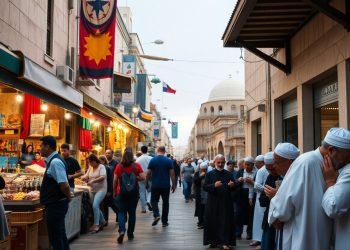The head of the Arab media division in the IDF Spokesperson Unit, Avichay Adraee, issued a call in Arabic to civilians still remaining in the Zitun and Turkmen neighborhoods of Gaza City, telling them to evacuate to the humanitarian areas south of the Gaza Strip on Tuesday morning.
The areas in which the directive was issued are located next to a significant junction that the IDF has cleared in the south of Gaza City, effectively dividing Gaza into two parts. This is one of the significant logistical operations that the IDF carried out in the Gaza Strip. IDF soldiers have created a partition on the Palestinian side of the Gaza border fence with Israel. It has already earned the nickname “Gaza crossroad” in both Israel and Gaza.
This partition is a straight line that stretches from the Gaza border in the area of Be’eri and Kibbutz Nahal Oz to the west and from the south of Gaza City to the coast, in the same area where the Karni-Netzerim junction used to be located.
Large numbers of IDF soldiers have been working on the construction and defense of the crossing since the IDF gained operational control of the areas next to it, and it is estimated that this significant change will last even after the war. Channel 14 recently revealed images of many parts of the road.
Expert approves of border dividing the Strip
In a conversation with Maariv Tuesday morning, Or Fialkov, an expert on Israeli wars and terrorism, who has been closely following the progress of the war in the Gaza Strip using open-source intelligence, said that this [border] is a significant obstacle that effectively divides Gaza into two parts.
“Israel is building a barrier between Gaza City and the rest of the Gaza Strip to the south,” he said, “so we can say, ‘Welcome to the reality where there are two separate regions instead of the Gaza Strip: the north of the Gaza Strip and the south of the Gaza Strip.’ The road is surrounded by dirt walls, and there are already operations on both sides of it to establish checkpoints aimed at managing the separation of Gaza City from the southern Strip.”
According to Fialkov, it is possible that Israel will later decide to pave additional borders in the Gaza Strip as part of shaping the post-war policy in the south. “In my opinion, Israel should also establish a similar barrier south of Khan Yunis,” he said, “so that if Hamas smuggles weapons through Rafah again, they will not spill over into the entire Gaza Strip but will only remain in the Rafah area. That way, Hamas in the Gaza Strip will not be able to arm itself as it has armed itself in recent decades.”
In the meantime, the IDF forces continue fighting in the Strip. According to the IDF spokesperson, IDF soldiers from the 7th Brigade combat intelligence team killed dozens of terrorists in western Khan Yunis on Monday by using tank and sniper fire, among other methods.
Additionally, combat soldiers from the Givati Brigade’s combat intelligence team in Khan Yunis identified a number of terrorists armed with an RPG-type missile and a Kalashnikov-type weapon and eliminated them at short range.
The Air Force, under the direction of the fire control center of Division 98, attacked a Hamas munitions warehouse in the area of the city of Khan Yunis. During the attack, secondary explosions were detected in the compound, which, according to the report, indicated the presence of several weapons.
In the center of the strip, the combat team of the Nahal Brigade continues to operate and has killed several terrorists throughout Tuesday. During the fighting, the brigade identified a terrorist in the area, directed sniper fire at him, and he was killed within a few minutes.










